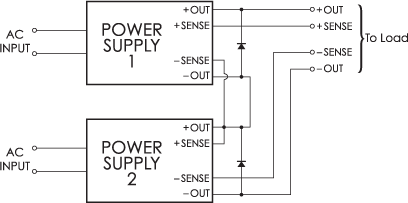Connecting Power Supplies in Series
Posted by Acopian Application Engineers
{Entry Date}
In :
Blog Archive
The outputs of two or more power supplies can be easily connected in
series to obtain a combined output with a higher voltage than provided
by a readily available standard supply. The outputs of two or more power
supplies can also be connected in series if the object is to obtain a
higher current at the required voltage, since lower voltage supplies
usually have higher current ratings. The power supplies could have
different voltages allowing greater flexibility of the final output
voltage.
However, three precautions should be observed.
First,
the combined voltage should not exceed the output breakdown voltage
rating of the supplies. So, for example, don’t connect the outputs of
three 200 volt supplies in series if their output breakdown voltage
rating is 600 volts or less.
Second, the output connections for
each power supply should have a reverse biased diode wired across them
(see drawing). This will assure that, if one supply comes up to voltage
before the other(s), it won’t apply a reverse polarity voltage to the
other(s) through the load and possibly damage it (them) or cause it
(them) to lock up. Each diode’s PIV and current rating should exceed
that of the entire series string. Note that when remote sensing is being
used, the voltage drop in the output wire connecting the supplies is
compensated by extending one supply’s sense lead to the output terminal
of the other supply.
Third, since the supplies are in series, the
current rating of each power supply must equal or exceed the maximum
current rating required by the load.
Also, intermediate voltages can be tapped off the connections between power supplies. For example, if four 12V supplies are connected in series to obtain 48V, the intermediate connections can be tapped for 12V, 24V and/or 36V outputs of the same polarity. Each power supply must, of course, have a current rating at least equal to the sum of the currents of all outputs that will be flowing through it. Therefore, if (using the same example) 10A will be drawn at each voltage, the supply between Common and 12V needs to be rated at least 40A, but the others need be rated at only 30A, 20A and 10A respectively.

Some possible combinations:
- 24Vdc@30A power supply in series with a
24Vdc@18A power supply can
be used as a
48Vdc@18A power supply. - 12Vdc@60A power supply in series with a
12Vdc@37A power supply can
be used as a
24Vdc@37A power supply. - 18Vdc@40A power supply in series with a
6Vdc@68A power supply can
be used as a
24Vdc@40A power supply - 18Vdc@40A power supply in series with a
6Vdc@40A power supply can
be used as a
24Vdc@40A power supply - 5Vdc@70A power supply in series with a
6Vdc@68A power supply and
in series with a
7Vdc@66A power supply can be used as an
18Vdc@66A power
supply